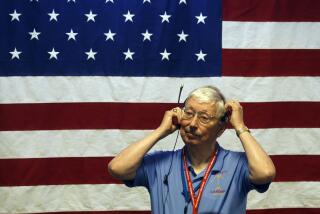Eye-in-Sky Designer Has Sights on Mars
On a bright Lancaster morning recently, as youthful joggers leisurely circled the Antelope Valley College track, a lanky, balding man in a red cap and frayed slacks started the engine of a model airplane nearby and sent it soaring aloft, using a radio controller.
As the joggers stared skyward, R. Dale Reed of Lancaster maneuvered the Ruthee II, a red-and-yellow craft with a 6-foot wingspan that he helped build, through dips and turns at up to 1,000 feet.
Unbeknown to those nearby, Reed also was triggering a simple automatic camera in the plane’s belly, taking panoramic photos of the people and terrain below--a rehearsal for what he hopes to accomplish some day over the red dunes of Mars.
Reed, 59, is no ordinary model airplane buff. An innovator, an inventor and aeronautical engineer, he has spent a career devising unusual aircraft for the National Aeronautics and Space Administration.
Over more than three decades, Reed has been the creative force behind a host of NASA projects, including pioneering work with remotely piloted aircraft and research that paved the way for the space shuttle.
But Reed’s ambition aims for a more distant goal: An experimental aircraft he designed is being considered by NASA for use in exploring Mars someday, in much the same way that Ruthee II circled Antelope Valley College.
His career has been distinguished, his awards are numerous, and he is commended by his peers. During his tenure with NASA, Reed managed 19 programs, designed 12 aircraft and got a patent for his Mars aircraft. But some of Reed’s most significant ideas have become victims of circumstance.
His concept of a Mars explorer, first developed in the mid-1970s, is one of those. Three prototypes of his propeller-driven aircraft, dubbed the Mini-Sniffer for its exploratory capabilities, sat idle at Edwards Air Force Base before they were moved to an Arizona university several years ago.
Now, with the U.S. government’s attention expanding from the space shuttle program outward to planned exploration of Mars in the 1990s, Reed has reason to hope again. “I’ve had enough experience over the years,” he said. “If you know something is right, you just hang in there until things change. There will be an airplane flown on another planet. It’s just a matter of when.”
Reed has been obsessed by aviation since he flew model planes as a 12-year-old in his native Idaho. He learned to fly at 16 and came to the Antelope Valley to work for NASA from 1953 until his retirement in 1985.
But retirement was short-lived. Reed spent the past four years designing aircraft at Lockheed Corp.’s “Skunk Works” facility in Burbank. In June, tiring of the long commute, he returned to Edwards to design for a NASA subcontractor, Planning Research Corp.
“My motivation is if it’s something new and never been charted before,” Reed said.
“I feel I’m a catalyst. I can get people started in different directions,” he added. “I will never be content with not being creative. I love airplanes. I’m hooked for life.”
Anyone who has watched the opening sequence of the television show “The Six-Million-Dollar Man” knows Reed’s work. The scene of actor Lee Majors’ spacecraft crashing in the desert is footage of the real 1967 crash near Edwards of a prototype rocket-powered craft designed by Reed.
On television, Majors ended up with superhuman strength. In real life, NASA test pilot Bruce Peterson was injured but survived the crash of the M2-F2, one in a series of wingless, flatiron-shaped spacecraft Reed pioneered that helped NASA design the space shuttles for re-entry to Earth’s atmosphere.
Reed’s work as project manager on the lifting body program from 1962 to 1969 led NASA to award him its exceptional service medal.
The series of so-called lifting bodies invented and successfully tested by Reed in the 1960s and early 1970s showed that a spacecraft, which could not have regular wings because they would be torn off in the re-entry process, could still make a gliding, airplane-like landing. Previously, spacecraft had plummeted and parachuted into the ocean.
But Reed’s wingless concept never quite made aerospace super-stardom, although his M2-F2 wound up on display at the Smithsonian. Reed had wanted his then-revolutionary design used for the Apollo missions to the moon, but NASA rejected that. And later, a new heat shielding breakthrough allowed NASA to equip the space shuttles with stubby wings, again foiling his design.
More to Read
Sign up for Essential California
The most important California stories and recommendations in your inbox every morning.
You may occasionally receive promotional content from the Los Angeles Times.










